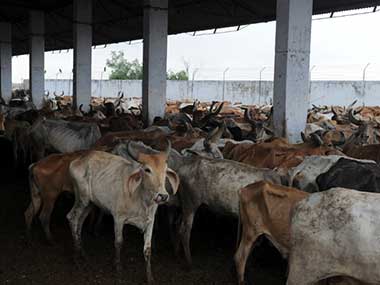Modi government’s new rules on sale of cattle for slaughter in market places is illogical and can push the farmers into distress. The government has banned sale of cattle for slaughter at market places. Not just cows, the regulation will cover bulls, bullocks, buffaloes, steers, heifers and camels, first reported by Hindustan Times (read here). Cattle can be sold only to a person with documents to prove he is an “agriculturist”, the rule says. “unfit animals” cannot be sold, the report said.
“The definition of cattle now involves buffaloes too, which wasn’t there so far. It will hurt the sector badly,” told DB Sabharwal, secretary of All India Meat & Livestock Exporters’ Association to Firstpost.
“Secondly, slaughter houses gets only 10 percent of the cattle directly from farmers. The rest 90 percent is from mandis, which is banned now. This is going to put the whole industry at risk,” said Sabharwal.
According to the notification notified under the Prevention of Cruelty to Animals (PCA) Act of 1960 that gives the Centre powers over animal welfare, the committees overseeing animal markets will have to take an undertaking from traders that “animals are bought for agriculture purposes and not for slaughter”.
The rules prohibit the sale of animals for slaughter through the livestock markets. The trade of cattle is allowed only between farmland owners. The trade now involves lot of paper work between the seller and buyer with respect to identity and ownership documents.
In all, about 30 norms are stipulated for animal markets, including water, fans, bedding, ramps, non-slippery flooring, veterinary facility and separate enclosure for sick animals. The rule says cattle can be sold only to a person having documents to prove he is an “agriculturist”, adding that “unfit animals” cannot be sold. Steps taken to ensure that only healthy animals are sold in market places are welcome. But, completely banning sales of cattle at market places can impact the poor farmer and hurt the industry badly for few reasons:
According to Sabharwal, farmers will find it hard to get rid of their old cattle unfit for either milk or breeding. The farmer bears a cost to maintain these unproductive animals—about Rs 60-80 per day.
Secondly, the notification can further embolden the self-appointed cow protection groups to interpret it in their own way and hurt even genuine traders. Already, after the Modi government has taken over, self-proclaimed gaurakshaks have popped up across the country taking the law into own hands. These groups may derive more strength from the government rule.
Third, shortage of cattle can impact the meat trade industry that employs millions. According to the Hindustan Times report, the annual meat business in India is estimated to be around Rs one lakh crore with exports worth Rs 26,303 crore in 2016-17, with Uttar Pradesh being the market leader followed by Andhra Pradesh, West Bengal and Telangana. “Already, the clampdown on illegal slaughter houses in UP has impacted legal slaughter houses as well. This rule will hurt slaughter houses even more,” Sabharwal said.
The Modi government, which wants to double the farmer income by 2022, could have tightened rules to clamp down on illegal sale instead of banning cattle sale outright in the open markets. A blanket ban will only hurt the poor farmers and cripple the meat industry since it is not always practical for slaughter houses to procure cattle directly from the farmers.



Leave a reply